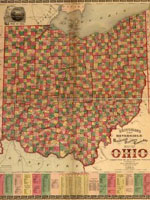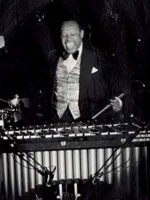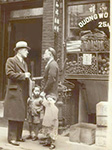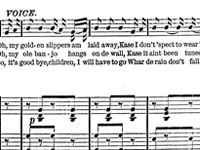1. The term "Jim Crow" originally referred to:
b. A popular burlesque song and theatrical dance number
 White actor, singer, and dancer, Thomas D. Rice, wrote and performed "Jim Crow" (sometimes called "Jump Jim Crow" because of the first line of the chorus) in 1829 or 1830. To perform the song, Rice dressed in tattered rags and frolicked comically to impersonate a very low caricature of a black man. His performances became an overnight sensation among white audiences, and he performed all over the country. He then took his act to Britain and France, where it became an even bigger hit.
White actor, singer, and dancer, Thomas D. Rice, wrote and performed "Jim Crow" (sometimes called "Jump Jim Crow" because of the first line of the chorus) in 1829 or 1830. To perform the song, Rice dressed in tattered rags and frolicked comically to impersonate a very low caricature of a black man. His performances became an overnight sensation among white audiences, and he performed all over the country. He then took his act to Britain and France, where it became an even bigger hit.
One dismayed English drama critic in the London Satirist, however, wrote: "Talent is of no country, neither is folly; and were 'Jim Crow' of English creation, we should have assuredly dealt as severely with it as we have now done with the bantling of the new world--perhaps more so, for we would have strangled it in its birth to prevent it begetting any more of its own species to offend the world's eye with their repulsive deformities. The circumstance of its being an exotic, the production of the pestilential marshes of backwood ignorance, has had no effect with us in giving our opinion. There is no concealing the fact, that Jim Crow owes its temporary triumph in this country to one of those lapses of human nature which sometimes occurs, when the senses run riot, and a sort of mental saturnalia takes place." Quoted in "Jim Crowism," Spirit of the Times (New York), February 4, 1837.
2. "Jim Crow cars" were separate railway passenger cars in which blacks were forced to travel, instead of in the passenger cars in which whites took their seats. The term "Jim Crow cars" first came into use:
a. In the mid-1830s, in Massachusetts and Connecticut
 Segregated public transportation began in the North before the Civil War. In many parts of the South, a black could not travel at all, unless he or she was accompanying (or accompanied by) a white, or carrying a pass from a white person.
Segregated public transportation began in the North before the Civil War. In many parts of the South, a black could not travel at all, unless he or she was accompanying (or accompanied by) a white, or carrying a pass from a white person.
The inconsistencies themselves bred conflict. One Massachusetts newspaper editor wrote, "South of the Potomac, slaves ride inside of stage-coaches with their masters and mistresses—north of the Potomac they must travel on foot, in their own hired vehicles, or in the 'Jim Crow' car. … What a black man is, depends on where he is. He has no nature of his own; that depends upon his location. Moreover the contradictions that appertain to him, produce corresponding contradictions in the white man. … Seriously, very seriously—do not the incongruities, the strange anomalies, in the condition of the coloured race, clearly show there is terrible wrong somewhere? … The confusion of tongues is terrible; the confusion of ideas is worse." From "Incongruities of Slavery," The Friend, March 26, 1842, quoting the [Worcester] Massachusetts Spy.
3. Among the very first deliberate African American challengers to Jim Crow practices in public transportation was:
b. Frederick Douglass, who refused, in 1841, to give up the first-class seat on the Eastern Railroad he took when he boarded the train at Newburyport, MA, and move to the train's Jim Crow car
 Douglass may not have been the very first, but he appears to have been one of the first. African Americans in New England, beginning in late 1839, along with white abolitionists, with some successes, deliberately challenged extra-legal but fairly common Jim Crow accommodations on railroads, on stagecoaches, in churches ("Negro pews"), and in schools. The persistence of Jim Crow practices in the North, however, gave Southern slave-holding whites the opportunity to reproach even abolitionist Northern whites for "not treating their free blacks better."
Douglass may not have been the very first, but he appears to have been one of the first. African Americans in New England, beginning in late 1839, along with white abolitionists, with some successes, deliberately challenged extra-legal but fairly common Jim Crow accommodations on railroads, on stagecoaches, in churches ("Negro pews"), and in schools. The persistence of Jim Crow practices in the North, however, gave Southern slave-holding whites the opportunity to reproach even abolitionist Northern whites for "not treating their free blacks better."
4. After the Civil War, the practice of formally segregating whites and blacks working in Federal Government offices was instituted during the administration of which U.S. President?
c. Woodrow Wilson
 Woodrow Wilson, who had been born in Virginia, soon after he took office in 1913, began a government-wide segregation of blacks and whites in Federal workplaces, restrooms, and lunchrooms. The policy appears to have been instituted after Wilson's Georgia-born wife Ellen visited the Bureau of Printing and Engraving in Washington and "saw white and negro women working side by side." Wilson's Secretary of the Treasury, William McAdoo (also Georgia-born, and soon to be the Wilsons' son-in-law) took the hint. Shortly thereafter, Assistant Secretary of the Treasury John Skelton Williams issued an order segregating the races in the Bureau. A Washington-wide order, covering all Government offices, followed, and soon all Federal offices everywhere in the country were covered by the same order.
Woodrow Wilson, who had been born in Virginia, soon after he took office in 1913, began a government-wide segregation of blacks and whites in Federal workplaces, restrooms, and lunchrooms. The policy appears to have been instituted after Wilson's Georgia-born wife Ellen visited the Bureau of Printing and Engraving in Washington and "saw white and negro women working side by side." Wilson's Secretary of the Treasury, William McAdoo (also Georgia-born, and soon to be the Wilsons' son-in-law) took the hint. Shortly thereafter, Assistant Secretary of the Treasury John Skelton Williams issued an order segregating the races in the Bureau. A Washington-wide order, covering all Government offices, followed, and soon all Federal offices everywhere in the country were covered by the same order.
 White actor, singer, and dancer, Thomas D. Rice, wrote and performed "Jim Crow" (sometimes called "Jump Jim Crow" because of the first line of the chorus) in 1829 or 1830. To perform the song, Rice dressed in tattered rags and frolicked comically to impersonate a very low caricature of a black man. His performances became an overnight sensation among white audiences, and he performed all over the country. He then took his act to Britain and France, where it became an even bigger hit.
White actor, singer, and dancer, Thomas D. Rice, wrote and performed "Jim Crow" (sometimes called "Jump Jim Crow" because of the first line of the chorus) in 1829 or 1830. To perform the song, Rice dressed in tattered rags and frolicked comically to impersonate a very low caricature of a black man. His performances became an overnight sensation among white audiences, and he performed all over the country. He then took his act to Britain and France, where it became an even bigger hit. Segregated public transportation began in the North before the Civil War. In many parts of the South, a black could not travel at all, unless he or she was accompanying (or accompanied by) a white, or carrying a pass from a white person.
Segregated public transportation began in the North before the Civil War. In many parts of the South, a black could not travel at all, unless he or she was accompanying (or accompanied by) a white, or carrying a pass from a white person. Douglass may not have been the very first, but he appears to have been one of the first. African Americans in New England, beginning in late 1839, along with white abolitionists, with some successes, deliberately challenged extra-legal but fairly common Jim Crow accommodations on railroads, on stagecoaches, in churches ("Negro pews"), and in schools. The persistence of Jim Crow practices in the North, however, gave Southern slave-holding whites the opportunity to reproach even abolitionist Northern whites for "not treating their free blacks better."
Douglass may not have been the very first, but he appears to have been one of the first. African Americans in New England, beginning in late 1839, along with white abolitionists, with some successes, deliberately challenged extra-legal but fairly common Jim Crow accommodations on railroads, on stagecoaches, in churches ("Negro pews"), and in schools. The persistence of Jim Crow practices in the North, however, gave Southern slave-holding whites the opportunity to reproach even abolitionist Northern whites for "not treating their free blacks better." Woodrow Wilson, who had been born in Virginia, soon after he took office in 1913, began a government-wide segregation of blacks and whites in Federal workplaces, restrooms, and lunchrooms. The policy appears to have been instituted after Wilson's Georgia-born wife Ellen visited the Bureau of Printing and Engraving in Washington and "saw white and negro women working side by side." Wilson's Secretary of the Treasury, William McAdoo (also Georgia-born, and soon to be the Wilsons' son-in-law) took the hint. Shortly thereafter, Assistant Secretary of the Treasury John Skelton Williams issued an order segregating the races in the Bureau. A Washington-wide order, covering all Government offices, followed, and soon all Federal offices everywhere in the country were covered by the same order.
Woodrow Wilson, who had been born in Virginia, soon after he took office in 1913, began a government-wide segregation of blacks and whites in Federal workplaces, restrooms, and lunchrooms. The policy appears to have been instituted after Wilson's Georgia-born wife Ellen visited the Bureau of Printing and Engraving in Washington and "saw white and negro women working side by side." Wilson's Secretary of the Treasury, William McAdoo (also Georgia-born, and soon to be the Wilsons' son-in-law) took the hint. Shortly thereafter, Assistant Secretary of the Treasury John Skelton Williams issued an order segregating the races in the Bureau. A Washington-wide order, covering all Government offices, followed, and soon all Federal offices everywhere in the country were covered by the same order.

 From the late 1880s to around 1940, Yiddish-language theatre found a home in New York City—as did the wave of Jewish immigrants who brought the performance form to the U.S. Fleeing persecution in Russia, these immigrants, whether they chose to be performing artists or audience members, developed a unique theatre culture. Unlike the short variety acts of contemporary vaudeville, Yiddish theatre presented full-evening-length plays, accompanied by music or broken up with song-and-dance numbers. Plays adapted popular works by authors like Shakespeare and Anton Chekhov, drew from folklore and folk customs, and/or commented on recent events in the U.S. and abroad. Some addressed issues of assimilation, such as intermarriage and generational gaps, while others praised the virtues of the immigrants' adopted country—as did the musicals mentioned above.
From the late 1880s to around 1940, Yiddish-language theatre found a home in New York City—as did the wave of Jewish immigrants who brought the performance form to the U.S. Fleeing persecution in Russia, these immigrants, whether they chose to be performing artists or audience members, developed a unique theatre culture. Unlike the short variety acts of contemporary vaudeville, Yiddish theatre presented full-evening-length plays, accompanied by music or broken up with song-and-dance numbers. Plays adapted popular works by authors like Shakespeare and Anton Chekhov, drew from folklore and folk customs, and/or commented on recent events in the U.S. and abroad. Some addressed issues of assimilation, such as intermarriage and generational gaps, while others praised the virtues of the immigrants' adopted country—as did the musicals mentioned above. In 1852, the Tong Hook Tong Dramatic Company arrived in California, following the stream of Chinese immigrants who had come to the state with the 1848 gold rush. Greeted warmly by immigrant audiences, they accepted a contract to perform in New York City. In New York, they discovered the contract was a scam, and secured their own theatre space, performing for New Yorkers independently. Chinese opera bears little resemblance to European opera, and even less to the "Oriental" image of China then popular on the mainstream stage. Confused by what they were seeing, New Yorkers rejected genuine Chinese theatre that did not match up with contemporary media stereotypes.
In 1852, the Tong Hook Tong Dramatic Company arrived in California, following the stream of Chinese immigrants who had come to the state with the 1848 gold rush. Greeted warmly by immigrant audiences, they accepted a contract to perform in New York City. In New York, they discovered the contract was a scam, and secured their own theatre space, performing for New Yorkers independently. Chinese opera bears little resemblance to European opera, and even less to the "Oriental" image of China then popular on the mainstream stage. Confused by what they were seeing, New Yorkers rejected genuine Chinese theatre that did not match up with contemporary media stereotypes. In 1965, Luis Valdez, the son of Chicano migrant farm workers, founded the theatrical company El Teatro Campesino. El Teatro Campesino took theatrical performances—often without props, sets, or written scripts—directly to the camps of migrant farm workers. In its performances, the company sought to inspire farm workers to form a farm workers' union, but it also performed pieces based on Mexican popular theatre: corridas (dramatized ballads), peladitos (comic skits with an underdog protagonist), and religious pageants.
In 1965, Luis Valdez, the son of Chicano migrant farm workers, founded the theatrical company El Teatro Campesino. El Teatro Campesino took theatrical performances—often without props, sets, or written scripts—directly to the camps of migrant farm workers. In its performances, the company sought to inspire farm workers to form a farm workers' union, but it also performed pieces based on Mexican popular theatre: corridas (dramatized ballads), peladitos (comic skits with an underdog protagonist), and religious pageants. Prior to the Great Migration of the early 20th century, when African Americans came north in search of a better life, major record companies released African American music, but only as performed by white performers. Sensing the potential for a new market, the companies began to record African American performers and release their music on special labels targeted at African American audiences. Called "race records," these records were later marketed to white audiences as well. African Americans also established their own companies to distribute records—the first African American owned label, Black Swan, was established in 1921. Many styles of music associated with race records would later be recategorized as "rhythm and blues."
Prior to the Great Migration of the early 20th century, when African Americans came north in search of a better life, major record companies released African American music, but only as performed by white performers. Sensing the potential for a new market, the companies began to record African American performers and release their music on special labels targeted at African American audiences. Called "race records," these records were later marketed to white audiences as well. African Americans also established their own companies to distribute records—the first African American owned label, Black Swan, was established in 1921. Many styles of music associated with race records would later be recategorized as "rhythm and blues."

 In 1790, federal marshals collected data for the first census, knocking by hand on each and every door. As directed by the U.S. Constitution, they counted the population based on specific criteria, including "males under 16 years, free White females, all other free persons (by sex and color), and slaves." There was no pre-printed form, however, so marshals submitted their returns, sometimes with additional information, in a variety of formats.
In 1790, federal marshals collected data for the first census, knocking by hand on each and every door. As directed by the U.S. Constitution, they counted the population based on specific criteria, including "males under 16 years, free White females, all other free persons (by sex and color), and slaves." There was no pre-printed form, however, so marshals submitted their returns, sometimes with additional information, in a variety of formats.
